For decades, CoreDux has been a pioneer in cryogenic and high-pressure artery systems for the industrial gas market and turbines. The acquired knowledge and knowhow is now being transferred to new markets such are New Energy (hydrogen turbines, fuel cells), High Tech (quantum computing, front-end semiconductor manufacturing, medical applications) and aeronautics & space, where these highly specialized hoses are becoming a necessity, today and in the years to come.
When you want to transport high-pressure gasses or when temperatures drop to cryogenic levels, you need high-end, high-quality hoses and artery solutions. Also for mobile applications where space is limited, such as in cars, planes and rockets, you can’t just buy your hoses online because they will not fit due to your constraints.
CoreDux has a proven track record of over twenty years in artery products for the most challenging environments. To illustrate this, we talk about the market for gas turbines. Historically, CoreDux used to be a big player in that industry, but over time the market matured. When all risks were mitigated by design, customers were happy to move to lower-cost products. But at the moment, gas turbines running on hydrogen are coming into play, raising the bar again, since the challenges associated with gaseous hydrogen are much bigger.

Now, when the going gets tough and the requirements become more demanding, only CoreDux has the tailor made solutions for these mission-critical and highly complex applications. Gas turbine manufacturers cannot afford to be frugal anymore; they need the highest quality. And therefore, CoreDux is rapidly gaining market share in gas turbines again.
New space
The decades of experience and innovation in cryogenic and high-pressure applications, for instance in the Turbine, Semiconductor and Medical industries, are starting to pay off in other markets as well. In segments such as New Energy, Aeronautics and Space, similar demanding conditions need to be tackled.
Cryogenic space applications have been in CoreDux project portfolio for a long time. Already in the development phase of the Ariane 5, for instance, CoreDux supplied its artery solutions. The last couple of years CoreDux sees the dawn of a new space age. There are still some big space institutions out there, but we see an increasing number of private endeavors. Not all of them will fly – literally – but it is definitely a market we can show our added value of cryogenic solutions.
Liquid hydrogen
Why do you need cryogenics for space applications? When you want to launch a satellite into space, you need a lot of power, and hydrogen is the most powerful fuel. Since the available space in a rocket is limited, you want the hydrogen and the oxygen in liquid form, and therefore cryogenic temperatures are required. Although hydrogen can be costly, this decade we anticipate a boom in cryogenic applications in that field.
Next is aeronautics, probably in the upcoming decade. The challenges are very much alike; a maximum of power in a minimum of space is vital. Planes flying shorter distances might run on high-pressure solutions for hydrogen gas, but when you’re talking long haul, liquid hydrogen is the way to go. Big aircraft manufacturers are already preparing for this switch, aiming for zero-emission planes from 2035 onwards.

Hydrogen value chain
The same range distinction is valid for road mobility; Long-range trucks need a lot of closely-packed power. So the combination of hydrogen and cryogenics is a no-brainer. For smaller vans or cars that does not make sense. But the dice are not cast yet.
Whatever the future will bring, CoreDux has the technology available to contribute to the whole hydrogen chain in land-based mobility. From production and storage, to distribution and usage. In electrolyzers that will produce the hydrogen, in the large-scale transport of liquefied hydrogen and in the usage in vehicles. With our artery systems for high-pressure and cryogenic media, CoreDux potentially can be present all along the value chain in hydrogen.
Quantum computing
Hydrogen is by no means the only fuel or substance in High Tech applications. Also, for instance, methane and helium are quite often used. A good example of the latter is in quantum computing. To bring such a system to cryogenic levels, helium is applied. High-quality, grade 6, very pure helium to be precise. Any contamination can ruin your machine so the artery system is a pivotal part of your setup. CoreDux has special processes in place to secure and retain moisture levels of as high as 10 PPB (parts per billion). Note that to guarantee this extreme level of cleanliness, products even have a shelf life, typically about three months. Helium atoms are minuscule so over time, it is inevitable that they will ‘permeate’. Interesting to notice is that with such minuscule leak rates exceeding x10-6 mbar l/sec permeation becomes pressure independent. Meaning that outside ambient air can make its way into the gas lines despite the pressure. Incorporating the right, completely leak-free, ‘fresh’ hoses is crucial for the quantum computer to run.
Permeation blocked
The flexible and innovative character of CoreDux makes sure that we can adapt to changes. Take permeation for instance. Legislation around that topic is far from finished. If it turns out that permeation is not allowed, CoreDux has the best credentials, as our stainless steel solutions are impregnable. You can imagine that you want to avoid hydrogen leakage in a plane at all costs. Permeation in those kind of environments is an absolute no-go. Compliance with European and worldwide directives is well mastered by CoreDux.
Embrittlement solved
Another topic to take into account, is in hydrogen embrittlement. That can be an issue in high-pressure applications. When you don’t take precautionary measures, hydrogen can affect the microstructure of the hose. CoreDux uses a proprietary modification of the standard 316L stainless steel, that can better withstand the hydrogen flow. Also over longer periods of time. The lifetime of a rocket might be about fifteen minutes, but it is a completely different challenge to achieve the same long-lasting result in airplanes that fly around for more than twenty years. Every applications is different and every design customer-specific, so we build on prior knowledge and our existing technical competence to test and validate all these aspects.
Insulation fixed
In cryogenic applications, it is obviously necessary to keep the temperatures low and to avoid regasification. The latter is especially tricky in case of hydrogen as it is the smallest molecule possible. Based on pre-existing technological bricks, CoreDux has solved the problem with Multi-Layer Insulation (MLI).
Ready for take-off
All the necessary building blocks are available at CoreDux. It is now a matter of scaling up, as we are talking about potentially millions of users. CoreDux is ready for the demand of today, and we are expanding our activities according to the trends we see in the market. So we will be fully prepared when the demand will fully take off.
With decades of experience under our belt, CoreDux has gained a higher understanding of the environments where high-pressure and cryogenic artery systems are required. We know the pitfalls and how to avoid them. We know your problem and have solved them before. CoreDux is at the forefront of innovation and can provide mature and innovative solutions based on known building blocks.






